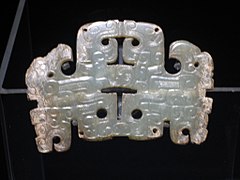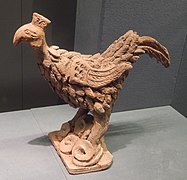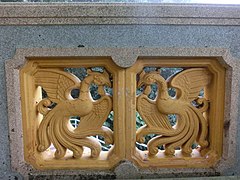Fenghuang
| Fenghuang | |
|---|---|
| Fenghuang in the Summer Palace , Beijing | |
| Chinese name | |
| Long characters | 鳳凰 |
| Abbreviation | 凤凰 |
| Pinyin | fènghuáng |
| Jyutping | fung 6 wong 4 |
| Japanese name | |
| Kanji | 鳳凰 |
| Kana | ほ う お う |
| Hepburn | hō-ō |
| Korean name | |
| Hangeul | 봉황 |
| Hanja | 鳳凰 |
| MR | ponghwang |
| RR | bonghwang |
| Vietnamese name | |
| Quốc Ngữ | phụng hoàng |
| Hán tự | 鳳凰 |
The Fenghuang ( Chinese 鳳凰 / 凤凰 , Pinyin fènghuáng , W.-G. fêng⁴-huang² ) is a mythological bird and a symbol of good luck in Chinese culture that protects the southern part of the emperor's palace. Feng denotes the male and huang the female.
Similar to the phoenix in Greek and Egyptian mythology , it is associated with fire . The mythical creature Fenghuang is also known as the "Chinese phoenix", but is basically a different mythical creature and should not be confused with it. In addition, it is not identical to the red bird , also the red bird of the south (Japanese suzaku ), which is a symbol of Chinese astrology alongside the white tiger, the blue dragon and the black turtle .
The Fenghuang has a long head with large, elongated eyes and a pointed, slightly curved beak, reminiscent of a pheasant or a peacock. Its long, colorful plumage shows the "five holy colors". So the head is green (for goodness), the neck white (for justice), the back red (for decency), the chest black (for wisdom) and the feet are yellow (for loyalty and credibility). The noble bird preferred the branches of the Wutong tree ( Firmiana simplex , syn. Sterculia platanifolia ) and is said to have only drunk from the best mountain springs. The age should have been around 1000 years. Like the Chinese unicorn ( qilin ), the fenghuang was a symbol of mercy . Unlike the Greek phoenix, the Fenghuang did not go up in flames to renew itself. Its reproduction was similar to that of normal birds.
Furthermore , the animal, together with the Chinese dragon ( Long ), symbolized the imperial couple. The dragon stood for the emperor, while the empress was symbolized accordingly by the Fenghuang. This was also one of the four mythical miracle animals (also magical beings) that helped the Chinese world creator Pangu .
gallery
- Fenghuang ornaments and pictures
Fenghuang and Long - Jade from spring and autumn periods , 2006
Fenghuang Devotee - Rock Crystal Southern Song Time , 2016
- Fenghuang figures
Fenghuang clay figure - Han period - Beijing, 2013
Fenghuang decoration - Ha Dynasty - Vietnam, 2007
Fenghuang wood carving - Fuxi Temple, Tianshui 2012
literature
- Wolfram Eberhard: Lexicon of Chinese symbols. The imagery of the Chinese. Heinrich Hugendubel, Munich 2004, ISBN 3-89631-428-9 , pp. 227-229.
- Josef Guter: Lexicon of the gods and symbols of the ancient Chinese. Marix, Wiesbaden 2004, ISBN 3-937715-04-5 , p. 260.
- Wolfgang Münke: Mythology of the Chinese antiquity. With an outlook on future developments. Peter Lang, European Science Publishing House, Frankfurt am Main 1998, ISBN 3-631-32776-5 , pp. 265-269.









